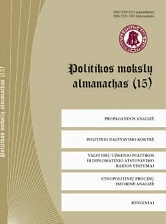THE IDEA OF PAN-SLAVIC ETHNOLINGUISTIC KINSHIP AND RECIPROCITY IN DALMATIA AND CROATIA, 1477–1683
THE IDEA OF PAN-SLAVIC ETHNOLINGUISTIC KINSHIP AND RECIPROCITY IN DALMATIA AND CROATIA, 1477–1683
Author(s): Vladislav B. SotirovićSubject(s): Politics / Political Sciences
Published by: Vytauto Didžiojo Universitetas
Keywords: Pan-Slavism; Pan-Croatianism; Slavic solidarity; Yugoslavism; Dalmatia;Balkans; South Slavic ethnolinguistic identity; South Slavic nationalism;
Summary/Abstract: This paper, as the main research task, sets out to examine and clarify historical development of the ideological concept of Pan-Slavism, which was created by the writers of Dalmatia and Croatia at the time of the late Renaissance and early Baroque (from the end of the 15th century to the end of the 17th century). The literary works of that time by many of Dalmatia’s and Croatia’s writers deal with the ethnolinguistic aspect of Pan-Slavic unity, solidarity, kinship and reciprocity. Their writings established an ideological framework for making both Pan-Slavic common national identity and program of the united single national state of the South Slavs in the Balkans. This “ethnolinguistic” framework of Pan-Slavic, and especially South Slavic, national identity became in the 19th and the 20th centuries the cornerstone of national ideology of Yugoslavism and Pan-Slavism which ultimately led to the creation of Yugoslavia in 1918 and its recreation in 1945. The main aspect of the ideology of Pan-Slavism and Yugoslavism that was developed in the literature and historical writings in Dalmatia and Croatia from 1477 to 1683 was based on the old domestic thought and tradition that all Slavs originated in the Balkans and that the South Slavs are autochthonous inhabitants of this peninsula.
Journal: Politikos mokslų almanachas
- Issue Year: 2014
- Issue No: 15
- Page Range: 175-187
- Page Count: 12
- Language: English

